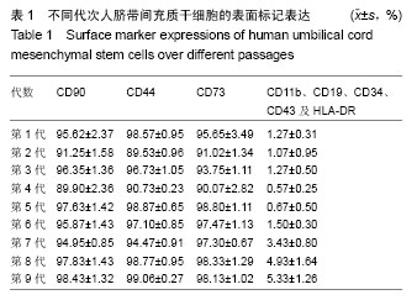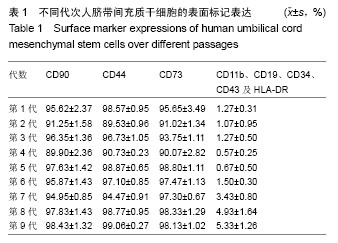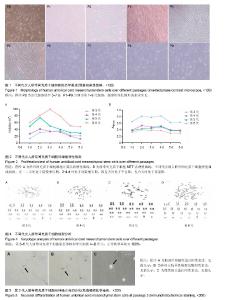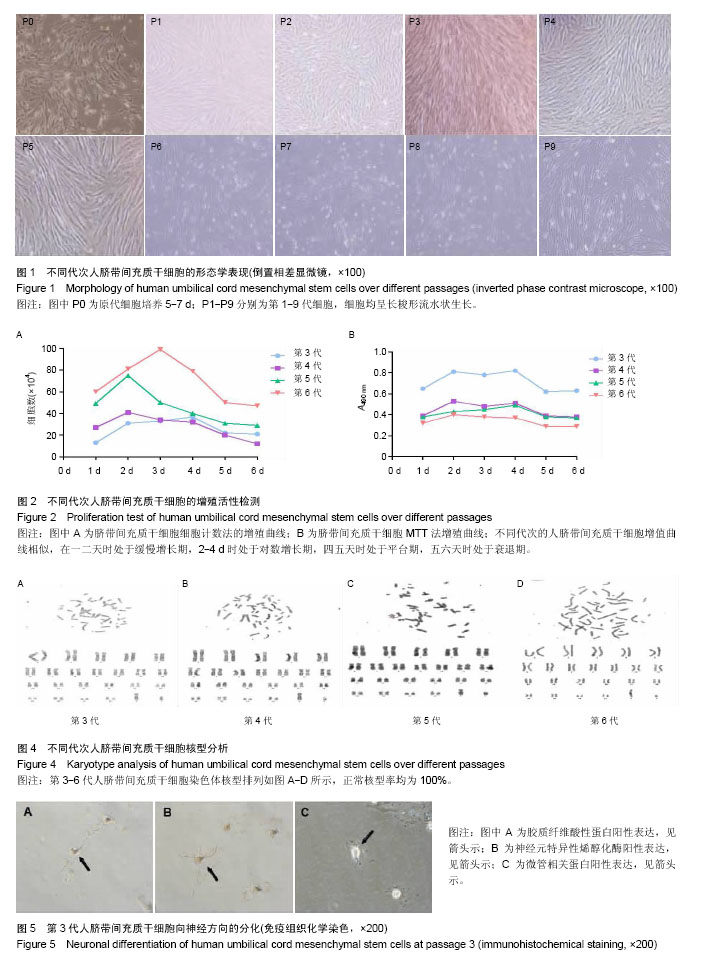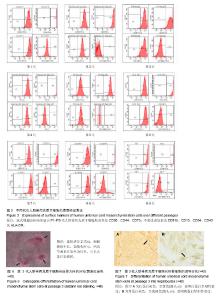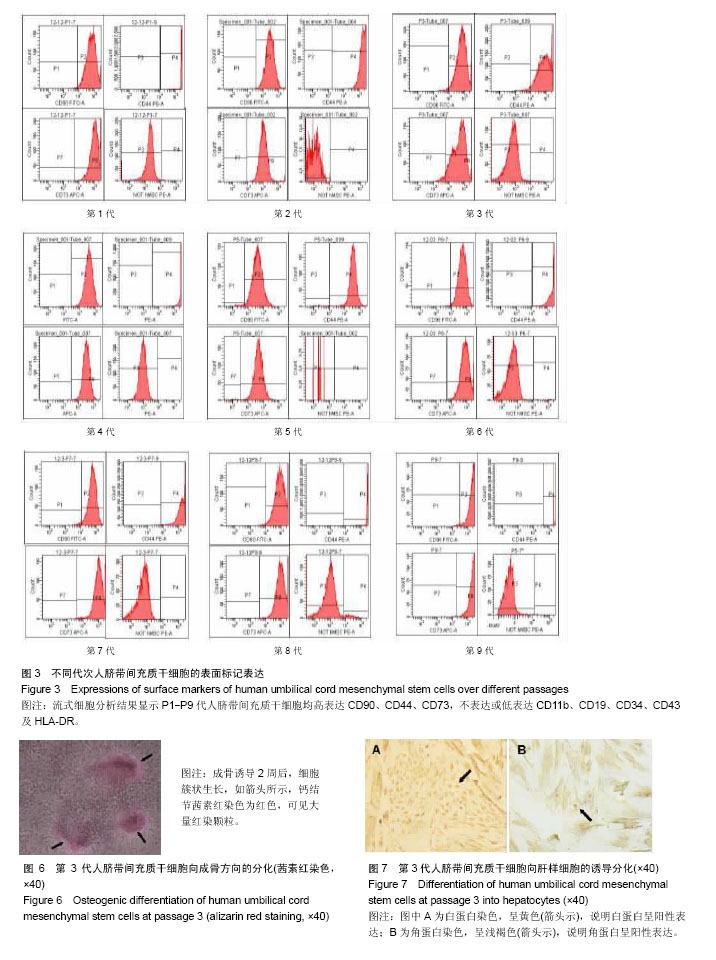| [1] Todeschi MR,Ei Bachiy R,Capelli C,et al. Transpiantedumbi icalcordmesenchyma stem cellsmodify the in vivo microenvironmenten hancingangiogenesis and leading to boneregeneration.Stem Cells Dev.2015;24(13):1570-1581.[2] Lindenmair A, Hatlapatka T,Kollwig G,et al. Mesenchymal stem or stromal cells from amnion and umbilical cord tissue and their potential for clinical applications.Cells.2012; 1:1061-1088.[3] Lindenmair A,Hatlapatka T,Kollwig G,et al.Mesenchymal Stem or Stromal Cells from Amnion and Umbilical Cord Tissue and Their Potential for Clinical Applications. Cells. 2012;1(4):1061-1088.[4] Parolini O,Alviano F,Bagnara GP,et al.Concise review: Isolation and characterization of cells from human term placenta: Outcome of the first international workshop on placenta derived stem cells.Stem Cells.2008;26:300-311.[5] Shi Z,Zhao L,Qiu G,et al.The effect of extendedpassaging on the phenotype and osteogenic potential of human umbilical cord mesenchymal stem cells.Mol Cell Biochem.2015; 401 (1/2):155-164.[6] Cheng H,Qiu L,Ma J,et al.Replicative senescence of human bone marrow and umbilical cord derived mesenchymal stem cells and their differentiation to adipocytes and osteobiasts. Mol Biol Rep.2011;38(8):5161-5168.[7] Remya NS,Nair PD.Mechanoresponsiveness of human umbilical cord mesenchymal stem cells in in vitro chondrogenesis-A comparative study with growth factor induction. J Biomed Mater Res A.2016;104(10):2554-2566. [8] Li S,Wang Y,Guan L,et al.Characteristics of human umbilical cord mesenchymal stem cells during ex vivo expansion.Mol Med Rep.2015;12(3):4320-4325. [9] 张立新,陈亚宝,叶军,等.脐带间充质干细胞染色体核型制备及安全评估[J].海南医学,2013,23(13):11-12.[10] Bao C,Chen W,Weir MD,et al.Effects of electrospun submicron fibers in calcium phosphate cement scaffold on mechanical properties and osteogenic differentiation of umbilical cord stem cells.Acta Biomater.2011;7(11): 4037-4044. [11] Chen E,Tang MK,Yao Y,et al.Silencing BRE Expression in Human Umbilical Cord Perivascular (HUCPV) Progenitor Cells Accelerates Osteogenic and Chondrogenic Differentiation.PLoS One.2013;8(7):e67896. [12] Hu Y,Liang J,Cui H,et al.Wharton's jelly mesenchymal stem cells differentiate into retinal progenitor cells.Neural Regen Res.2013;8(19):1783-1792.[13] Wang L,Ott L,Seshareddy K,et al.Musculoskeletal tissue engineering with human umbilical cord mesenchymal stromal cells.Regen Med.2011;6(1):95-109.[14] Fu YS,Cheng YC,Lin MY,et al.Conversion of human um-bilical cord mesenchymal stem cells in Wharton's jelly to do-paminergic neurons in vitro: potential therapeutic application for Parkinsonism.Stem Cells.2006;24(1):115-124.[15] Xie L,Lin L,Tang Q,et al.Sertoli cell-mediated differentiation of male germ cell-like cells from human umbilical cord Wharton’s jelly derived mesenchymal stem cells in an in vitro co-culture system.Eur J Med Res.2015;20(1):9. [16] Li WW,Wei YH,Li H,et al.Isolation and Characterization of a Novel Strain of Mesenchymal Stem Cells from Mouse Umbilical Cord: Potential Application in Cell-Based Therapy. PLoS One.2013;8(8):e74478.[17] Weinand C,Pomerantseva I,Neville CM,et al. Hydrogel-beta-TCP scaffolds and stem cells for tissue engineering bone.Bone.2006;38(4):555-563. [18] Barberini DJ,Freitas NP,Magnoni MS,et al.Equine mesenchymal stem cells from bone marrow, adipose tissue and umbilical cord:immunophenotypic characterization and differentiation potential.Stem Cell Res Ther.2014;5(1):25.[19] Hao H,Chen G,Liu J,et al.Culturing on Wharton’s jelly extract delays mesenchymal stem cell senescence through p53 and p16INK4a/pRbpathways.PLoS One.2013; 8(3):e58314.[20] Joseph M,Das M,Kanji S,et al.Retention of stemness and vascul ogenic potential of humanumbilical cord blood stem cells after repeated expansions on PES- nanofibermatrices. Biomateriais.2014;35(30):8566-8575.[21] Zhang D,Kiiian KA.The effect of mesenchymal stem cell shape on the maintenance of multipotency. Biomaterials. 2013;34(16):3962-3969.[22] 赵庆华,祝家学,王雷.人脐带间充质干细胞生物学的特性及向软骨细胞、骨细胞分化实验研究[J].中华医学杂志,2011, 91(5): 317-321.[23] Zhou CH,Yang B,Tian Y,et al.Immunomodulatory effect of human umbilical cord Wharton’s jelly-derived mesenchymal stem cells on Iymphocytes.Cell Immunol.2011;(1):33-38.[24] Josse C,Schoemans R,Niessen NA,et al.Systematic chromosomal aberrations found in murine bone marrow-derived mesenchymal stem cells.Stem Cells Dev.2010;19(8): 1167-1173.[25] Grade M,Michael J.Difilippantonio,Jordi Camps.Patterns of Chromosomal Aberrations in Solid Tumors.Cancer Res. 2015;200:115-142.[26] Kim DM,Staples M,Shinozuka K,et al.Wharton’s Jelly-Derived Mesenchymal Stem Cells: Phenotypic Characterization and Optimizing Their Therapeutic Potential for Clinical Applications. Int J Mol Sci.2013;14(6):1692-11712. [27] Yan M,Sun M,Zhou Y,et al.Conversion of Human Umbilical Cord Mesenchymal Stem Cells in Wharton’s Jelly to Dopamine Neurons Mediated by the Lmx1a and Neurturin In Vitro: Potential Therapeutic Application for Parkinson’s Disease in a Rhesus Monkey Model.PLoS One. 2013;8(5): e64000.[28] 邓蓉蓉,谢伊旻,谢林.间充质干细胞归巢的研究与进展[J].中国组织工程研究,2016,20(19):2879-2888. |
